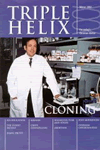Backed with £47.5 million, the long awaited government's first National Strategy for Sexual Health and HIV Services [1] was launched on 27 July 2001 by the Deputy Chief Medical Officer, Dr Sheila Adam and GUM consultant, Prof Michael Adler.
The launch was timed to coincide with the release of the latest STI figures by the PHLS. [2] These showed a continuing escalation of STIs in the UK. Particular causes for concern include the highest number of cases of gonorrhoea for over a decade (new cases rose by 27% between 1999 and 2000), sharply increased diagnoses of chlamydia (with, on average, one new case diagnosed every ten minutes in the UK) and increases in STIs among gay and bisexual men well above that seen in the general population (gonorrhea in this group was up 49% from 1999-2000).
The full details of the strategy [1] contain some very timely specific proposals such as targeted screening for chlamydia and the offer of hepatitis B vaccination to more at-risk groups. However the general trends and the strategy's assumptions give cause for concern.
Though HIV is the fourth largest killer worldwide, [3] in the UK it comprises a small number of cases of STI in comparison with the number of non-HIV STIs. Yet the very title of the strategy document gives undue emphasis to HIV over non-HIV diseases and this is reflected throughout the text. Few people have not heard of AIDS and HIV but, as the document acknowledges, most people do not know what chlamydia is. Yet in spite of this, the strategy does not cover sex education in its remit so there is little chance that education in schools about non-HIV STIs will improve as a result of its implementation.
There is also no evidence of comprehensive and joined-up measures to try and tackle prevention of STIs and unplanned pregnancy together. This is perhaps because the usually proposed solutions for both in isolation (condoms and oral contraception) have their weaknesses exposed when viewed in the light of the dual problem. Even if condoms were the solution to STIs alone, why do the case numbers continue to rise in spite of increasing condom use in the UK? The recent Center for Disease Control Report on condom effectiveness [4] throws doubt about the wisdom of condom promotion as the primary means of STI reduction. For example, the CDC report found no evidence that condoms provide any protection against HPV, the causative agent of genital warts and the commonest STI in the UK.
In the Lancet recently, three other experts from Prof Adler's own department concluded, 'We should ask why condom promotion is apparently not having much effect in most developing countries and whether we have the right balance between messages about condom promotion and partner reduction or selection.' [5]
This latter question is not considered at all by the document, despite many professional submissions to the committee suggesting this was a vital but neglected area to consider. Some wise words from another important document are very relevant: 'Sexual drives are strong, but marriage is strong enough to contain them and provide for a balanced and fulfilling sexual life in a world of sexual disorder.' [6]
Successive government initiatives however seem totally blind to this concept and STIs will continue to rise this year as a consequence.
Infections diagnosed at genitourinary medicine clinics in England in 1999
- Chlamydia (51083)
- Gonorrhoea (15572)
- Primary and secondary syphilis (206)
- Primary herpes (15863)
- First-episode human papillomavirus (61559)
- Hepatitis B (793)
- Trichomoniasis (5901)
- Newly diagnosed HIV (1471)
- Bacterial vaginosis (57294)































